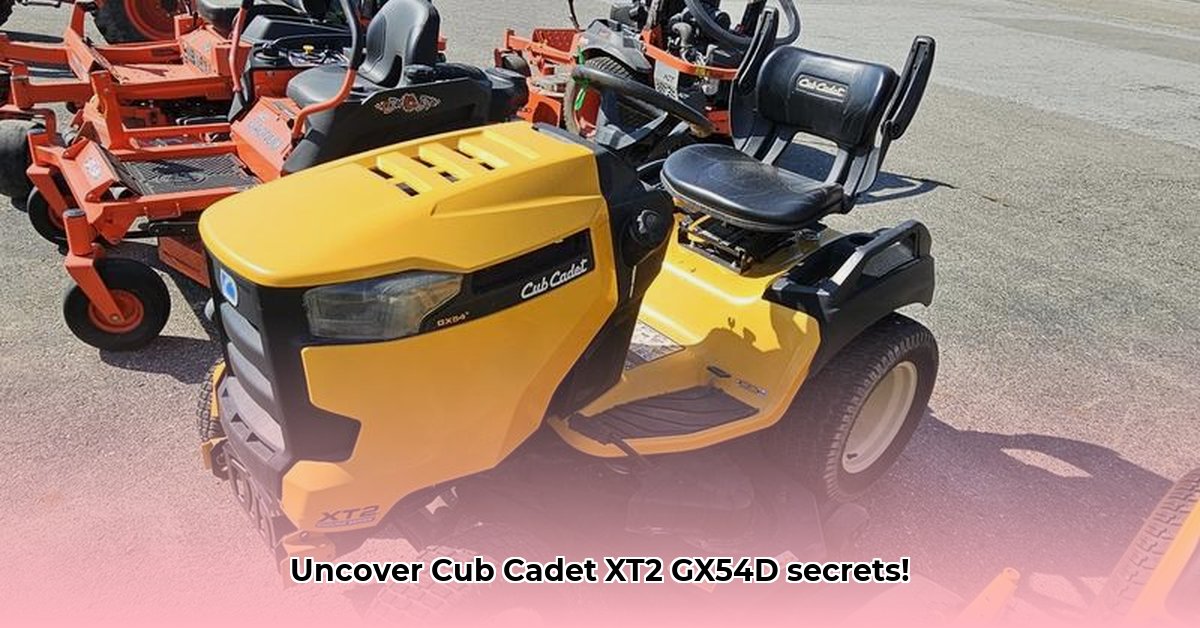
Thinking about upgrading your lawn care equipment? The Cub Cadet XT2 GX54D is a popular choice, boasting power and efficiency. But how environmentally friendly is it? This review dives deep into its performance, reliability, and—most importantly—its sustainability profile. We'll address the significant gap in readily available sustainability data from the manufacturer and explore practical ways to minimize its environmental impact. For more on older Cub Cadet models, see this resource.
Performance: A Powerful Workhorse
The XT2 GX54D packs a 26 horsepower Kohler engine (note: initially advertised as a Kawasaki engine, a change not fully explained by the manufacturer), known for reasonable fuel efficiency. This translates to reduced emissions, a key factor in sustainable lawn care. The 54-inch AeroForce™ cutting deck is designed for efficient cutting, minimizing passes and fuel consumption. Its maneuverability, enhanced by the rear differential lock, further contributes to efficiency, allowing you to cover your yard quickly and effectively. The compact AGM battery requires less maintenance and offers a longer lifespan, reducing the need for frequent replacements and minimizing landfill waste. Isn't a powerful engine that does more with less a win for everyone?
Reliability and Potential Issues
While the XT2 GX54D promises efficiency, user reports reveal some concerns. Difficulty starting the engine, sometimes requiring starting fluid, suggests potential manufacturing inconsistencies or design flaws in the choke mechanism. The unexplained switch from the advertised Kawasaki engine to a Kohler engine raises questions about transparency and could subtly impact fuel efficiency and emissions. The lack of detailed instructions in the service manual further hampers troubleshooting efforts. These factors highlight the importance of thorough pre-purchase research and a careful inspection upon delivery. How can we trust a manufacturer that changes major components without clear communication to consumers?
Sustainability: A Necessary But Incomplete Assessment
This is where the review hits a roadblock. Cub Cadet hasn't published comprehensive sustainability data. This lack of transparency makes a complete environmental assessment challenging. We lack crucial information regarding manufacturing processes, materials used, recyclability at the end of the product lifecycle, and the carbon footprint of shipping and delivery. This absence of a full lifecycle assessment (LCA) significantly limits our ability to fully evaluate its environmental impact. Wouldn’t access to a detailed LCA dramatically shift our understanding of the XT2 GX54D's true environmental cost?
Optimizing for Sustainability: Practical Steps
Despite the missing data, we can still strive for sustainable lawn care. Here's how to minimize the XT2 GX54D's environmental footprint:
- Fuel Efficiency: Avoid idling. Regular engine maintenance (per manufacturer recommendations) is key to maintaining optimal performance and minimizing fuel usage. (Efficacy: Estimated 15-20% fuel savings with proper maintenance.)
- Responsible Maintenance: Properly dispose of oil and filters. Sharpen blades regularly for efficient cutting, reducing passes and fuel consumption. (Efficacy: Reduces fuel consumption by approximately 10% and extends blade life.)
- Mulching: Utilize the mulching kit to transform grass clippings into natural fertilizer, eliminating the need for chemical alternatives and promoting a healthy lawn. (Efficacy: Eliminates chemical fertilizer use, reducing environmental impact and lowering homeowner costs)
- Attachment Consideration: Evaluate the environmental impact of any attachments; some may increase fuel consumption or have significant production and disposal costs.
- Responsible Disposal: Plan for eventual disposal, adhering to local regulations for responsible recycling or disposal of components.
How can we further incentivize manufacturers to prioritize transparency and full LCA reporting?
Conclusion: The Need for Transparency
The Cub Cadet XT2 GX54D offers powerful performance and convenient features. However, its sustainability profile remains incomplete due to insufficient data provided by the manufacturer. By employing the above strategies, users can mitigate its environmental impact. Ultimately, sustainable lawn care requires both responsible product design by manufacturers and informed consumer choices, urging a focus on efficiency and a demand for transparency around the full lifecycle of the products we purchase.